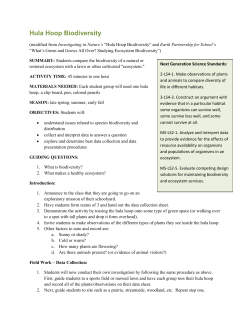
HS-LS2-7 - Next Generation Science Standards
HS-LS2-7 Students who demonstrate understanding can: HS-LS2-7. Design, evaluate, and refine a solution for reducing the impacts of human activities on the environment and biodiversity.* [Clarification Statement: Examples of human activities can include urbanization, building dams, and dissemination of invasive species.] The performance expectation above was developed using the following elements from A Framework for K-12 Science Education: Science and Engineering Practices Constructing Explanations and Designing Solutions Constructing explanations and designing solutions in 9–12 builds on K–8 experiences and progresses to explanations and designs that are supported by multiple and independent student-generated sources of evidence consistent with scientific ideas, principles, and theories. Design, evaluate, and refine a solution to a complex real-world problem, based on scientific knowledge, student-generated sources of evidence, prioritized criteria, and tradeoff considerations. January 2015 Disciplinary Core Ideas LS2.C: Ecosystem Dynamics, Functioning, and Resilience Moreover, anthropogenic changes (induced by human activity) in the environment — including habitat destruction, pollution, introduction of invasive species, overexploitation, and climate change — can disrupt an ecosystem and threaten the survival of some species. LS4.D: Biodiversity and Humans Biodiversity is increased by the formation of new species (speciation) and decreased by the loss of species (extinction). (secondary) Humans depend on the living world for the resources and other benefits provided by biodiversity. But human activity is also having adverse impacts on biodiversity through overpopulation, overexploitation, habitat destruction, pollution, introduction of invasive species, and climate change. Thus sustaining biodiversity so that ecosystem functioning and productivity are maintained is essential to supporting and enhancing life on Earth. Sustaining biodiversity also aids humanity by preserving landscapes of recreational or inspirational value. (secondary) (Note: This Disciplinary Core Idea is also addressed by HSLS4-6.) ETS1.B: Developing Possible Solutions When evaluating solutions it is important to take into account a range of constraints including cost, safety, reliability and aesthetics and to consider social, cultural and environmental impacts. (secondary) Crosscutting Concepts Stability and Change Much of science deals with constructing explanations of how things change and how they remain stable. Page 1 of 2 Observable features of the student performance by the end of the course: 1 2 3 4 Using scientific knowledge to generate the design solution a Students design a solution that involves reducing the negative effects of human activities on the environment and biodiversity, and that relies on scientific knowledge of the factors affecting changes and stability in biodiversity. Examples of factors include but are not limited to: i. Overpopulation; ii. Overexploitation; iii. Habitat destruction; iv. Pollution; v. Introduction of invasive species; and vi. Changes in climate. b Students describe the ways the proposed solution decreases the negative effects of human activity on the environment and biodiversity. Describing criteria and constraints, including quantification when appropriate a Students describe and quantify (when appropriate) the criteria (amount of reduction of impacts and human activities to be mitigated) and constraints (for example, cost, human needs, and environmental impacts) for the solution to the problem, along with the tradeoffs in the solution. Evaluating potential solutions a Students evaluate the proposed solution for its impact on overall environmental stability and changes. b Students evaluate the cost, safety, and reliability, as well as social, cultural, and environmental impacts, of the proposed solution for a select human activity that is harmful to an ecosystem. Refining and/or optimizing the design solution a Students refine the proposed solution by prioritizing the criteria and making tradeoffs as necessary to further reduce environmental impact and loss of biodiversity while addressing human needs. January 2015 Page 2 of 2
© Copyright 2025





















